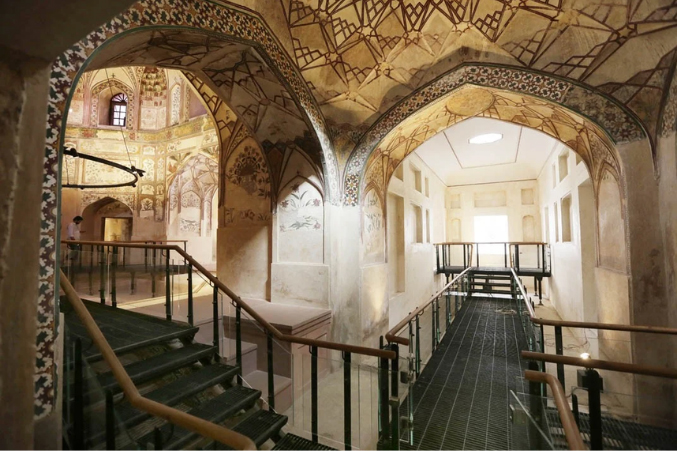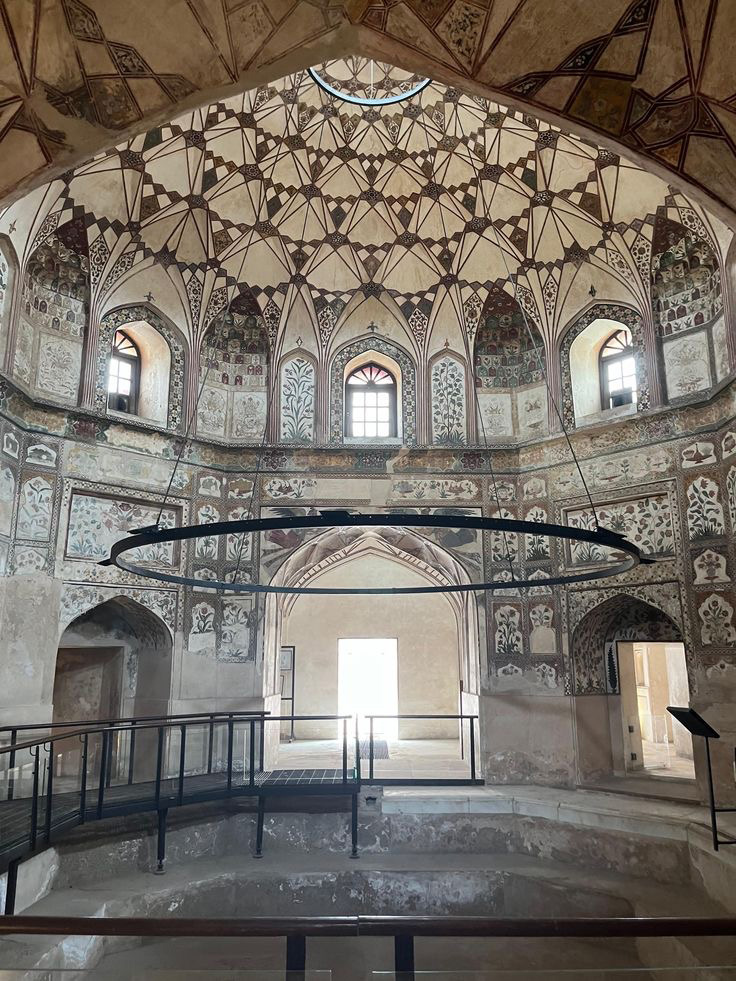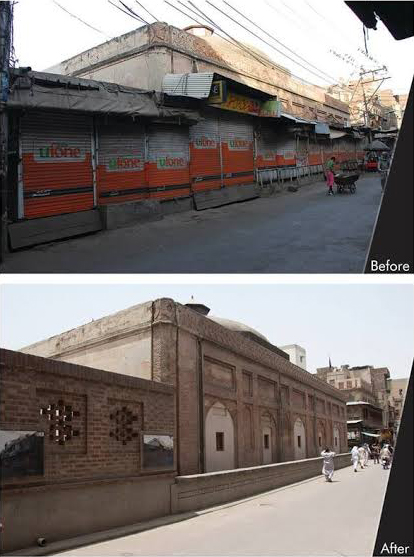Queen Noor Jahan’s Mysterious Ailment and a Bold Cure
The Mughal Queen Noor Jahan, wife of Emperor Jahangir, was plagued by an incurable ailment that baffled all local herbalists (Hakeem) and physicians. Desperation led a courtier to mention a renowned Hakeem from Chiniot, Ilm Ud Din Ansari, prompting the Emperor to summon him to Lahore to relieve the Queen’s suffering.
Upon his arrival at the Mughal court, Hakeem Ilm Ud Din Ansari quickly diagnosed the cause of the Queen’s pain—a cyst beneath her foot. Ingeniously, he prescribed walking on burning sand, which miraculously cured her. The city’s celebrations marked the Queen’s recovery, and the Hakeem was immediately appointed as the officer of the hospitals.
Hakeem Ilm Ud Din Ansari – Healer To Royal Prominence
Historical records reveal that Ilm Ud Din’s prominence rose within the royal court. He gained the favour of Shah Jahan, Jahangir’s son, and played a crucial role in resolving numerous court manoeuvrings. Following Jahangir’s death, Shah Jahan ascended the throne and honoured the Hakeem with the title of Nawab Wazir Khan, eventually appointing him as the Governor of Lahore.
The Rise of Wazir Khan: From Court Physician to Governor of Lahore
During his tenure, Wazir Khan adorned Lahore with a plethora of splendid structures, including grand mosques, lush gardens, luxurious baths (hammams), caravanserais, bustling bazaars, and opulent havelis. Among these, the construction of the Wazir Khan Hammam stands out. Today, this remarkable bathhouse, known as Shahi Hammam or Wazir Khan Hammam, continues to tell its fascinating story.
Architectural Marvels of Wazir Khan
One of the magical structures that Wazir Khan introduced was the royal bathhouse, called the Shahi Hamam, built in the Turkish-style in the 17th Century. The Shahi Hammam is the only one of its kind in Asia, and one will be unable to find this design and architecture anywhere else in the world.
As you pass through the towering arches of Delhi Gate in Lahore’s historic fort city, you’ll notice the Shahi Hammam on the left. Constructed by the Mughal Emperor Akbar, this bathhouse is surrounded by stunning Mughal architecture. The Shahi Hammam holds a significant place in Lahore’s cultural heritage.
Shahi Hammam – Structure, Design, and Functionality
Interestingly, the Hammam had three main sections: the hot chamber, the warm chamber, and the cold chamber. The hot chamber, or steam room, was heated by a furnace located outside the bathhouse. The steam was directed into the chamber through a system of pipes and vents. The warm chamber was used for washing and scrubbing, and the cold chamber was used for relaxation.
Strategically located, the Hammam welcomed travellers entering Lahore through the Delhi Gate. Visitors could refresh themselves here before heading to the nearby Wazir Khan Mosque for prayers. The Hammam was impeccably managed, providing a fashionable and essential service for both travellers and locals.
Attendants greeted patrons, guiding them through the available services. The Hammami, or bath attendant, supplied towels and soap, directing guests to the waiting area until their turn.
Once called, patrons enjoyed hot or cold baths and massages, all at affordable prices to cater to various economic classes. Imagine the grandeur of this place and the tranquil beauty it offered.

The Fall and Revival of Shahi Hammam- UNESCO Recognition
As the Mughal era waned, so did the splendour of the Hammam. Under Sikh rule, its heating system was destroyed, and decorative ornaments were stripped from its ceilings and walls. The British Raj repurposed the Hammam into offices and residences for police and soldiers.
Post-independence in 1947, it became a boys’ primary school, a girls’ vocational school, a dispensary, and various government offices. Residences for Government employees were even constructed on the rooftop.
The Department of Auqaf rented out the historical significance, the Walled City of Lahore Authority removed fifty-two encroachments from its façade and initiated a comprehensive conservation plan. The Aga Khan Culture Services Pakistan provided technical support, and in 2014, the Royal Norwegian Embassy funded the conservation. By 2016, the restoration was complete, earning the
northwestern rooms (Hujras) as shops, and further encroachments disfigured the northern, western, and southern façades. These alterations not only damaged the structure but also caused water ingress into the foundations. Minor restoration by the government efforts in 1991 proved unsustainable.
In 2012, recognising the Shahi Hammam’s
Shahi Hammam the UNESCO Award of Merit for best conservation practices in Pakistan.

Conservation Efforts and International Support
During the restoration, chemicals were used to remove the whitewash covering the frescoes, revealing the original artwork beneath. Fresco experts from Sri Lanka, in collaboration with students from the National College of Arts, meticulously restored these paintings. The Archaeology Department’s marble floors from 1991 were excavated to expose the ancient hypocaust system.
Historians claim that the Hammam was once a vast complex, partially demolished during the British reconstruction of Delhi Gate. Excavations uncovered the foundations of these lost sections, along with the main water channel, now preserved for tourists.
One original dome remains intact over the hot bath area. The waiting area has been transformed into a sitting area, and a small museum now occupies one of the galleries, displaying artifacts uncovered during the excavation.

Conservation Efforts and International Support
The Department of Auqaf rented out the northwestern rooms (Hujras) as shops, and further encroachments disfigured the northern, western, and southern façades. These alterations not only damaged the structure but also caused water ingress into the foundations. Minor restoration by the government efforts in 1991 proved unsustainable.
Historians claim that the Hammam was once a vast complex, partially demolished during the British reconstruction of Delhi Gate. Excavations uncovered the foundations of these lost sections, along with the main water channel, now preserved for tourists. One original dome remains intact over the hot bath area. The waiting area has been transformed into a sitting area, and a small museum now occupies one of the galleries, displaying artifacts uncovered during the excavation.

Hypocaust System Engineering of the Shahi Hammam
Beneath its floors lay a network of steam channels, known as the hypocaust system. Large furnaces burned wood to heat water, producing steam that circulated through these channels, warming the floors and water reservoirs.
Water pipes, cleverly concealed within the walls, supplied fresh water, while used water drained through floor channels into a central pipeline, eventually joining the main drain. Small ceiling openings provided ventilation and natural light. Each room had a specific purpose, from hot baths to cold baths and massages.
Strategically located, the Hammam welcomed travelers entering Lahore through the Delhi Gate. Visitors could refresh themselves here before heading to the nearby Wazir Khan Mosque for prayers. The Hammam was impeccably managed, providing a fashionable and essential service for both travellers and locals.
Lahore Walled City’s Crown Jewel Today
Today, this Hammam is a crown jewel of tourism inside Delhi Gate and along the Royal Trail. It draws thousands of visitors, standing as a testament to architectural brilliance. Remarkably, it is the only Hammam of its kind in Asia, unmatched by those in Shalimar Garden and the Fort in both beauty and scale. Indeed, Pakistan is fortunate to possess such historical masterpieces.
It is only Hammam of its kind in Asia.
A Living Heritage
The Hammam is one of the most famous tourist spots right inside Delhi Gate and The Royal Trail, attracting thousands of visitors almost every day. Right outside the Hammam, the Walled City Authority established a souvenir shop and a small café for the tourists. The conservation of this heritage site was a first-of-its-kind project in Punjab. The heritage site is open to the public to explore its various chambers, learn about their functions, and delve into the rich Mughal history.






